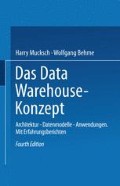Zusammenfassung
Data Warehouses sind einer der entscheidenden Wettbewerbsfaktoren für ein Unternehmen. Sie zeichnen sich aus durch das Anbieten unternehmensrelevanter Informationen in einer speziell für Endbenutzer aufbereiteten Form, wie in diversen Beiträgen dieses Buches gezeigt wird. Unabhängig von den verschiedenen Organisationsformen eines Data Warehouses sind folgende Eigenschaften für eine Betrachtung von Datensicherheitsaspekten insbesondere interessant:
-
Das Data Warehouse erhält seine Daten über Transformationsprogramme aus unterschiedlichen Datenquellen. Diese können unternehmensintern und extern sein.
-
Das Data Warehouse speichert die transformierten Daten in einer oder eventuell mehreren Datenbanken. Die Datenstrukturen beschreiben unternehmensbestimmende Sachverhalte. Sie dienen der Entscheidungsfindung im Unternehmen und geben Einsicht in historische Entwicklungen.
-
Das Data Warehouse enthält sowohl aktuelle als auch historische Daten aus allen eingebundenen Unternehmensbereichen in unterschiedlichen Verdichtungsstufen. Es können verschiedene Verdichtungsfunktionen nebeneinander eingesetzt werden (Summe, Aggregation, Durchschnitt usw.).
-
Es stehen eine Reihe von Abfrage- und Auswertefunktionen zur Verfügung, die durch unterschiedlich (DV-technisch) qualifizierte Endbenutzer einfach gebraucht werden können.
Access this chapter
Tax calculation will be finalised at checkout
Purchases are for personal use only
Preview
Unable to display preview. Download preview PDF.
Literatur
http://wvvw.datafellows.com/vir-info//vir-info/ http://agn-www.informatik.uni-hamburg.de/vtc//vtc/ http://ciac.llnl.gov/http://www.icsa.net/services/consortia/anti-virus/certifiedproducts.shtml/services/consortia/anti-virus/certifiedproducts.shtml http://csrc.nist.gov/nistpubs/select//nistpubs/select/
Bellovin S.: Security Problems in the TCP/IP Protocol Suite, in: Computer Communication Review: 19(1989)2.
Bellovin, S.: Steve Bollovin’s Posting on IP Spoofing, 1995.
Bonyum, D.A.: Logging and accountability on database management systems, in: Landwehr, C.E. (ed): Database Security: Status and Prospects, North Holland (Elsevier), 1988, S. 223–228.
Brinkrolf, J.: Sicherheit in Client- / Server-Systemen, DuD: 22(1998) 2, S. 86–90.
Chapman, D.B.; Zwicky-O’Reilly, E.D.: Building Internet Firewalls, O’Reilly & Associates 1995.
Cheswick, W. R.; Bellovin, S.M.: Firewalls and Internet security, Addison-Wesley 1994.
DamkerH.; Federrath, H.; Schneider, M.: Maskerade-Angriff im Internet, in: DuD: 20 (1996)5, S. 286–294.
Denning, D.E.: A Lattice Model of Secure Information Flow, in: ACM Communication: 19 (1976) 5, S. 236–243.
Denning, D.E.: The Tracker: A Threat to Statistical Data Base Security, in: ACM-TODS: (1979) 3, S. 76–96.
Dobbertin, H.: Digitale Fingerabdrücke, in: DuD: 21 (1997) 2, S. 82–87.
Donnerhacke, L.: ActiveX als Füllhorn für Langfinger — Vorsicht Falle, in: iX: März 1997.
Fox, D.: Fälschungssicherheit digitaler Signaturen, in: DuD: 21 (1997) 2, S. 69–74.
Hagemann, H.; Schaup, S.; Schneider, M.: Sicherheit und Perspektiven elektronische Zahlungssysteme, in: DuD: 23 (1999) 1, S. 5–12.
Horster, P.: Kryptologie, Zürich, Reihe Informatik Band 47, 1985.
Jones, A. K.; Lipton, R. J.; Snijder, L.: A Linear Time Algorithm for Deciding Security, Proc. of the Annual Symp. on Foundations of Computer Science, 1976.
NBS, Data Encryption Standard, NBS Federal Information Processing Standards Publication, No. 46, 1977.
Mcleish, M.: Further Results on the Security of Partioned Dynamic Statistical Databases, in: ACM Trans. Database Systems: 14, 1 (March 1989) S. 98–113.
Munzert, M.; Wolff, C.: Firewalls — Schutz vor Angriffen aus dem Internet, in: DuD: 20 (1996)2, S. 89–93.
Microsoft Corp.: Microsoft Windows NT Guidelines for Security, Audit and Control, Microsoft Press, Redmont, Washington, 1995.
Richter, B.; Sobirey, M.; König, H.: Auditbasierte Netzüberwachung, in: Praxis der Informationsverarbeitung und Kommunikation (PIK): 1/1996, S. 24–32.
Rivest, R.L.; Shamir, A.; Adleman, L.: A method for obtaining digital signatures and public key cryptosystems, in: Communications ACM: 21, 1978, S. 294.
Schaefer, M.; Hubbard, B.; Sterne, D.; Haley, T.K.; McAuliffe, J.N.; Wolcott, D.: Auditing: A relevant contribution to trusted database management systems, proc. of the 5th Annual Computer Security Applications Conference, Tucson, TX, Dec. 1989.
Schläger, U.: Datenschutz in Netzen, DuD 19 (1995) 5, S. 270–275.
Schlörer, J.: Information loss in partitioned statistical databases, in: Computer Journal: 26, 3 (1983), S. 218–223.
Schneier, B., Applied cryptography, John Wiley & Sons, 1996.
Sobirey, M.: Datenschutzorientierte Audit-basierte Erkennung von IT-Sicherheitsverletzungen, Dissertation, TU Cottbus, Oktober 1998.
Steiner, M.; Karjoth, G.; Hauser, R.: Management von Sicherheitsdiensten in verteilten Systemen, in: DuD: 19 (1995) 3, S. 150–155.
Trusted Oracle 7 Technical Overview, http://www.oracle.com.
Unix System Laboratories: Audit Trail Administration, Prentice Hall, Englewood Cliffs, NJ, 1993.
Venema, W.: TCP-Wrapper: Network monitoring, access control, and booby traps, Proc. of the 3th Usenix Unix Security Symposium, Baltimore, MD, Sept. 1992, 85–92.
Weck, G.: Sicherheit von Client-/ Server-Systemen, in: DuD: 19(1995)3: S. 156–163; 19 (1995) 4: S. 224–231; 19 (1995) 5: S. 276–283.
Editor information
Editors and Affiliations
Rights and permissions
Copyright information
© 2000 Springer Fachmedien Wiesbaden
About this chapter
Cite this chapter
Gerhardt, W., Pohl, H., Spruit, M. (2000). Informationssicherheit in Data Warehouses. In: Mucksch, H., Behme, W. (eds) Das Data Warehouse-Konzept. Gabler Verlag, Wiesbaden. https://doi.org/10.1007/978-3-322-89533-2_2
Download citation
DOI: https://doi.org/10.1007/978-3-322-89533-2_2
Publisher Name: Gabler Verlag, Wiesbaden
Print ISBN: 978-3-409-42216-1
Online ISBN: 978-3-322-89533-2
eBook Packages: Springer Book Archive

